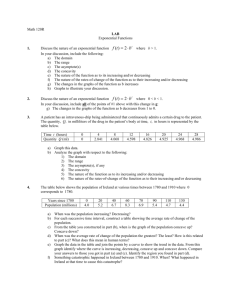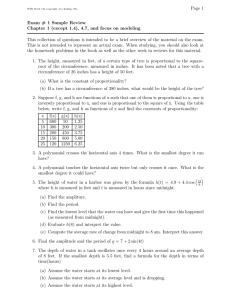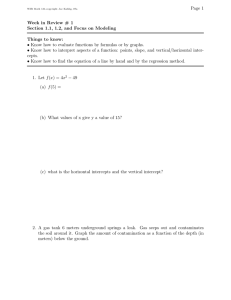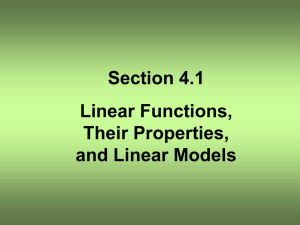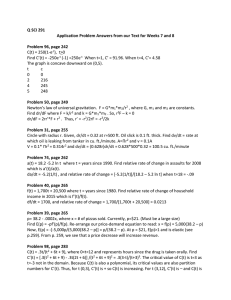Page 1 Week in Review # 2 Section 1.3 and 1.5
advertisement
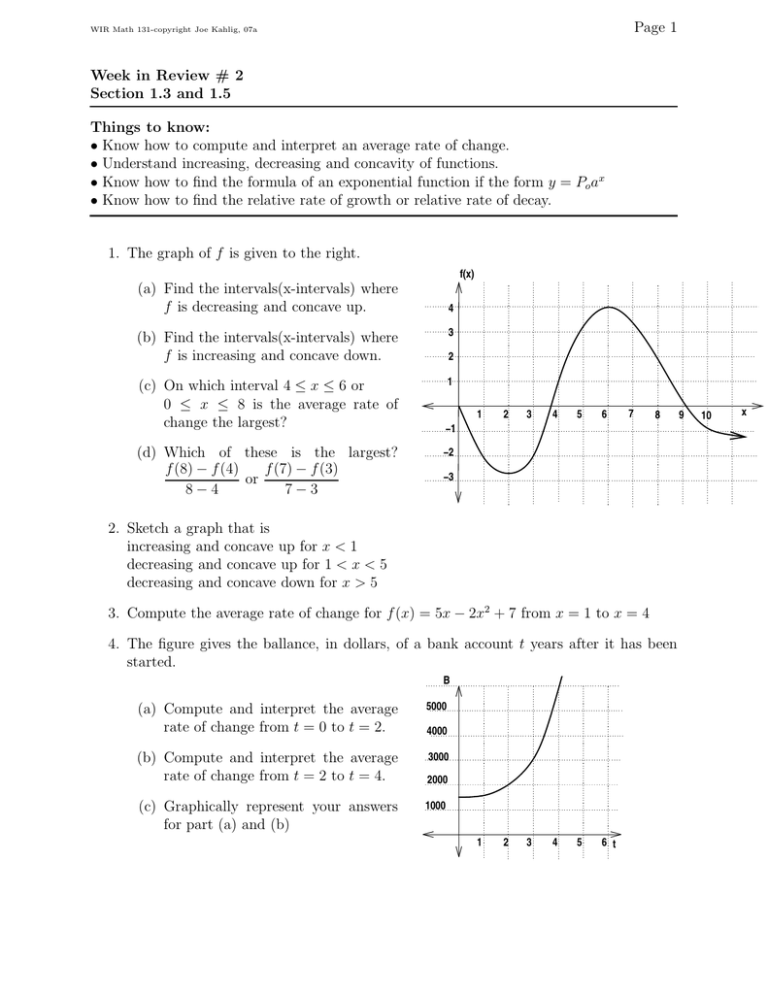
Page 1 WIR Math 131-copyright Joe Kahlig, 07a Week in Review # 2 Section 1.3 and 1.5 Things to know: • Know how to compute and interpret an average rate of change. • Understand increasing, decreasing and concavity of functions. • Know how to find the formula of an exponential function if the form y = Po ax • Know how to find the relative rate of growth or relative rate of decay. 1. The graph of f is given to the right. f(x) (a) Find the intervals(x-intervals) where f is decreasing and concave up. 4 (b) Find the intervals(x-intervals) where f is increasing and concave down. 3 (c) On which interval 4 ≤ x ≤ 6 or 0 ≤ x ≤ 8 is the average rate of change the largest? 1 (d) Which of these is the largest? f (7) − f (3) f (8) − f (4) or 8−4 7−3 2 1 2 3 4 5 6 7 8 −1 −2 −3 2. Sketch a graph that is increasing and concave up for x < 1 decreasing and concave up for 1 < x < 5 decreasing and concave down for x > 5 3. Compute the average rate of change for f (x) = 5x − 2x2 + 7 from x = 1 to x = 4 4. The figure gives the ballance, in dollars, of a bank account t years after it has been started. B (a) Compute and interpret the average rate of change from t = 0 to t = 2. 5000 (b) Compute and interpret the average rate of change from t = 2 to t = 4. 3000 (c) Graphically represent your answers for part (a) and (b) 4000 2000 1000 1 2 3 4 5 6 t 9 10 x WIR Math 131-copyright Joe Kahlig, 07a Page 2 5. The following graph shows the daily average retail price of regular gasoline in the Dallas area. (a) What is the average rate of change of gas prices from December 26 to January 16? Interpret this answer. (b) What is the average rate of change of gas prices from December 29 to January 8? Interpret this answer. 6. For these exponential formulas give the initial value and the relative growth/decay rate(percent rate of change). (a) y = 37(.87)x (b) y = 100(1.034)x 7. Find the exponential formula for the data sets. (a) x 2 y 50 5 6.25 (b) 3 5 x y 1728 2488.32 8. Give a possible formula for these statements. (a) The city’s population increased by 12% each year. (b) The city’s population increased by 200,000 each year. (c) A person is given a dose of a drug and the drug disappears(used by the body) by 4% per minute. (d) The lollypops at a pediatrician office are decreasing at a rate of 135 per day. 9. You are told that the function f (x) is an exponential function and that f (2) = 300. If the function has an average rate of change of 600 from x = 2 to x = 5, find an exponential formula for this function. WIR Math 131-copyright Joe Kahlig, 07a Page 3 10. A patient is given a 75mg dose of a drug. This drug leaves the body at a rate of 8.25% per hour. (a) How much of the drug is in the body after 3 hours? (b) How much of the drug is in the body after 12 hours? 11. A pesticide has a half life of 7 days. A crop is sprayed with this pesticide. (a) Find the percentage of the chemical still on the plants after 3 days. (b) The FDA will not approve a pesticide for use on commercial crops if that pesticide has a relative rate of decay that is less than 12% per day. Is this pesticide approved for use on commercial crops by the FDA? justify your answer. (c) How long will it take until less than 25% of the pesticide is still on the plants?

